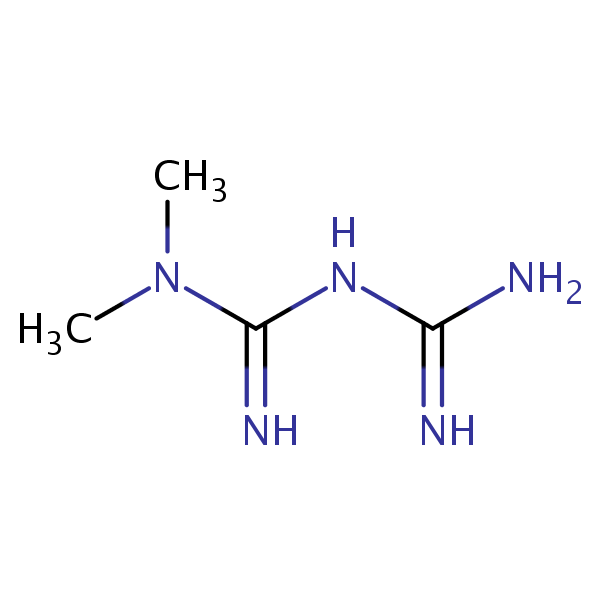| CAS Number | 657-24-9 |
|---|---|
| Molecular Formula | C4H11N5 |
| Molecular Weight | 129.168 |
| InChI Key | XZWYZXLIPXDOLR-UHFFFAOYSA-N |
| LogP | -1.37 |
| Synonyms |
|
Applications:
HPLC Method for Analysis of Metformin on Primesep 100 Column
February 1, 2024
High Performance Liquid Chromatography (HPLC) Method for Analysis of Metformin on Primesep 100 by SIELC Technologies
Separation type: Liquid Chromatography Mixed-mode SIELC Technologies
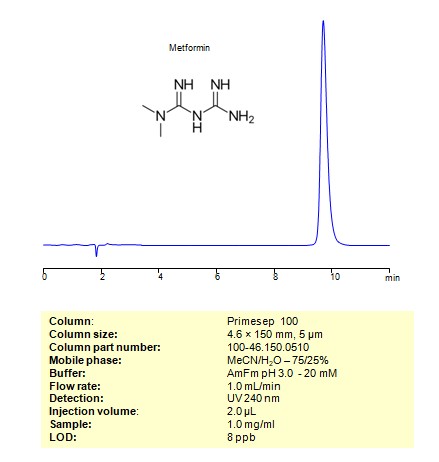
High Performance Liquid Chromatography (HPLC) Method for Analysis of Metformin
Biguanides, including Moroxydine, Metformin, Proguanil, and Phenformin, are a group of organic compounds that share a common structural feature, namely the presence of two guanidine groups.
Metformin is an oral antidiabetic medication used to treat type 2 diabetes. It works by reducing glucose production in the liver and improving insulin sensitivity in peripheral tissues. Metformin is one of the most widely prescribed drugs for diabetes management.
These biguanides exhibit various pharmacological activities, and while some are primarily used for antidiabetic purposes, others have applications in antiviral or antimalarial treatments. It’s important to note that the safety and efficacy of these drugs depend on proper medical supervision and adherence to prescribed dosages.
Metformin can be retained and analyzed using a Primesep 100 mixed-mode stationary phase column. The analysis employs an isocratic method with a simple mobile phase comprising water, acetonitrile (MeCN), and ammonium formate as a buffer. This method allows for detection using UV at 240 nm
| Column | Primesep 100, 4.6 x 150 mm, 5 µm, 100 A, dual ended |
| Mobile Phase | MeCN/H2O 75/25% |
| Buffer | AmFm pH 3.0 – 30 mM |
| Flow Rate | 1.0 ml/min |
| Detection | UV 240 nm |
| Samples | 0.5 mg/ml |
| Injection volume | 2 µl |
| LOD* | 8 ppb |
| Class of Compounds | Biguanides |
| Analyzing Compounds | Metformin |
Application Column
Primesep 100
Column Diameter: 4.6 mm
Column Length: 150 mm
Particle Size: 5 µm
Pore Size: 100 A
Column options: dual ended

HPLC Method for Separation Biguanides such as Moroxydine, Metformin, Proguanil and Phenformin on Primesep 100 Column
February 1, 2024
High Performance Liquid Chromatography (HPLC) Method for Analysis of Moroxydine, Metformin, Proguanil and Phenformin on Primesep 100 by SIELC Technologies
Separation type: Liquid Chromatography Mixed-mode SIELC Technologies
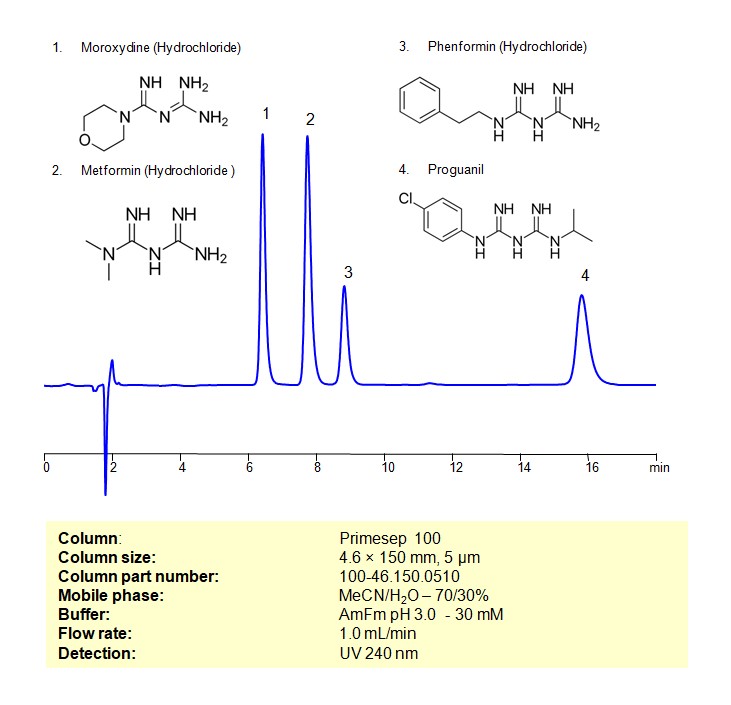
High Performance Liquid Chromatography (HPLC) Method for Analysis of Moroxydine , Metformin, Proguanil and Phenformin
Biguanides, including Moroxydine, Metformin, Proguanil, and Phenformin, are a group of organic compounds that share a common structural feature, namely the presence of two guanidine groups.
Moroxydine:
- Moroxydine is an antiviral medication used in the treatment of influenza. It is believed to inhibit the early stages of viral replication.
Metformin:
- Metformin is an oral antidiabetic medication used to treat type 2 diabetes. It works by reducing glucose production in the liver and improving insulin sensitivity in peripheral tissues. Metformin is one of the most widely prescribed drugs for diabetes management.
Proguanil:
- Proguanil is an antimalarial medication often used in combination with other drugs, such as atovaquone. It is used for both prevention and treatment of malaria. Proguanil is a prodrug, and its active form inhibits the development of the malaria parasite in the liver.
Phenformin:
- Phenformin is an antidiabetic biguanide that was previously used to treat type 2 diabetes. However, due to the risk of lactic acidosis (a serious side effect), it has been largely withdrawn from the market in many countries.
These biguanides exhibit various pharmacological activities, and while some are primarily used for antidiabetic purposes, others have applications in antiviral or antimalarial treatments. It’s important to note that the safety and efficacy of these drugs depend on proper medical supervision and adherence to prescribed dosages.
Biguanides such as Moroxydine , Metformin, Proguanil and Phenformin be retained, separated and analyzed using a Primesep 100 mixed-mode stationary phase column. The analysis employs an isocratic method with a simple mobile phase comprising water, acetonitrile (MeCN), and ammonium formate as a buffer. This method allows for detection using UV at 240 nm
| Column | Primesep 100, 4.6 x 150 mm, 5 µm, 100 A, dual ended |
| Mobile Phase | MeCN/H2O 70/30% |
| Buffer | AmFm pH 3.0 – 30 mM |
| Flow Rate | 1.0 ml/min |
| Detection | UV 240 nm |
| Samples | 1. 0.1 mg/ml 2. 0.1 mg/ml 3. 0.1 mg/ml 4. 0.1 mg/ml |
| Injection volume | 10 µl |
| LOD* | 1. 7 ppb 2. 7 ppb 3. 17 ppb 4. 18 ppb |
| Class of Compounds | Biguanides |
| Analyzing Compounds | Metformin, Proguanil hydrochloride, Phenformin, Moroxydine |
Application Column
Primesep 100
Column Diameter: 4.6 mm
Column Length: 150 mm
Particle Size: 5 µm
Pore Size: 100 A
Column options: dual ended
Moroxydine
Phenformin
Proguanil hydrochloride

HPLC Method for Separation of Guanylurea and Metformin on Primesep 100 Column
November 27, 2023
HPLC Method for Analysis of Guanylurea, Metformin on Primesep 100 by SIELC Technologies
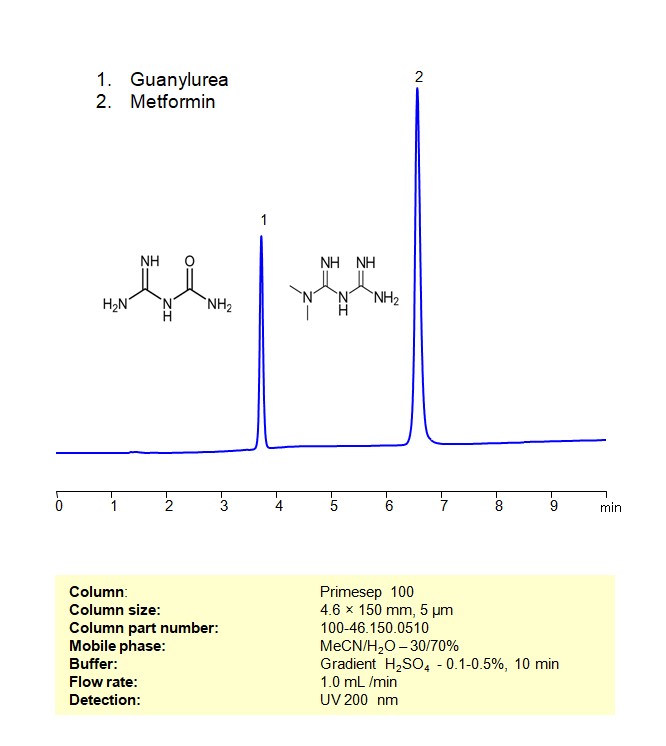
High Performance Liquid Chromatography (HPLC) Method for Analysis of Guanylurea, Metformin
Guanylurea is a known degradation product of metformin. When metformin undergoes biotransformation in the body, one of the metabolic pathways leads to the formation of guanylurea. This process is a part of the pharmacokinetics of metformin, where the drug is metabolized and eventually excreted from the body.
The conversion of metformin to guanylurea is significant for a few reasons:
Pharmacokinetics: Understanding the metabolism of metformin, including its conversion to guanylurea, is important for comprehending its action in the body, its elimination, and any potential metabolite-related effects.
Environmental Impact: The presence of pharmaceuticals and their metabolites, like guanylurea from metformin, in the environment (especially in water sources) has become a topic of environmental concern. This is because these compounds can have effects on aquatic life and potentially re-enter the human water supply.
Safety and Efficacy: Knowing the metabolites of a drug helps in assessing its safety and efficacy. While guanylurea is not known to have significant pharmacological effects in the context of metformin’s use as a diabetes medication, its identification is essential for a complete understanding of the drug’s profile.
Guanylurea: This is the main known metabolite of metformin. It is formed through the breakdown of metformin in the liver. Despite being the primary metabolite, guanylurea is considered to have minimal pharmacological activity, especially in the context of the glucose-lowering effects of metformin.
Guanylurea and Metformin can be retained, separated and analyzed on a Primesep 100 mixed-mode stationary phase column using an analytical method with a simple mobile phase of water, Acetonitrile (MeCN), and a sulfuric acid as a buffer. This analysis method can be detected using UV at 200 nm.
| Column | Primesep 100, 4.6 x 150 mm, 5 µm, 100 A, dual ended |
| Mobile Phase | MeCN/H2O – 30/70% |
| Buffer | Gradient H2SO4 -0.1-0.5%, 10 min |
| Flow Rate | 1.0 ml/min |
| Detection | UV 200 nm |
| Sample | Guanylurea phosphate 0.2 mg/ml in H2O and 1,1-Dimethylbiguanide hydrochloride 0.2 mg/ml in H2O |
| Class of Compounds | Ureas |
| Analyzing Compounds | Guanylurea, Metformin |
Application Column
Primesep 100
Column Diameter: 4.6 mm
Column Length: 150 mm
Particle Size: 5 µm
Pore Size: 100 A
Column options: dual ended
Metformin

HPLC Analysis of Metformin
July 8, 2011
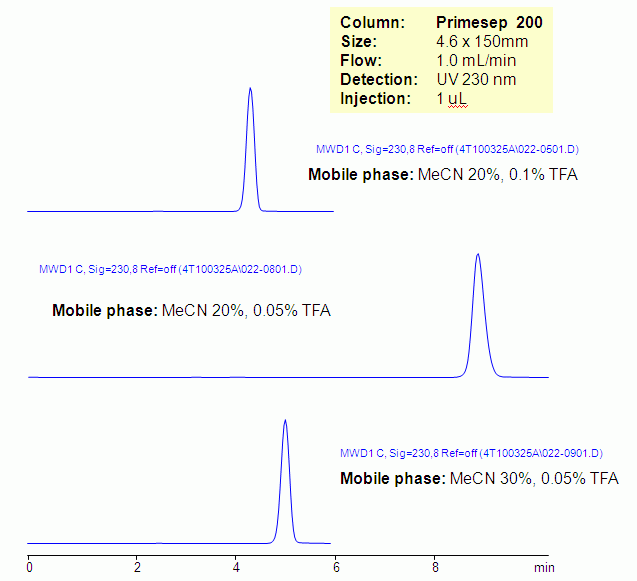
Metformin is a biguanide-based anti-diabetic drug. It is a very polar organic compound that has no retention on reversed-phase column unless an ion-pairing reagent is employed. Metformin was retained on a Primesep 200 column based on cation-exchange mechanism. Method can be used for analysis of metformin and related substances in pharmaceutical formulations. Due to low UV activity a more UV-transparent mobile phase is required. Metformin can be also monitored by ELSD and LC/MS with corresponding mobile phase (TFA, ammonium formate or ammonium acetate).
| Column | Primesep 200, 4.6×150 mm, 5 µm, 100A |
| Mobile Phase | MeCN/H2O |
| Buffer | TFA |
| Flow Rate | 0.5 ml/min |
| Detection | UV, 230 nm |
| Class of Compounds |
Drug, Anti-diabetic medication, Hydrophilic, Ionizable |
| Analyzing Compounds | Metformin |
Application Column
Primesep 200
The Primesep family of mixed-mode columns offers a wide variety of stationary phases, boasting unprecedented selectivity in the separation of a broad array of chemical compounds across multiple applications. Corresponding Primesep guard columns, available with all stationary phases, do not require holders. SIELC provides a method development service available to all customers. Inquire about our specially-tailored custom LC-phases for specific separations.
Select options
